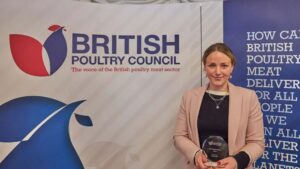Leading industry figures discussed the true cost of food waste and how to fight it in a dedicated webinar in March
How to tackle food waste is one of the great challenges of the modern era, and in a special webinar as part of Poultry Business’s ‘What if…?’ series in conjunction with the British Poultry Council and sponsored by Elanco, experts explored the extent to which poultry firms are already reducing waste and the barriers preventing them from doing more.
The webinar, hosted by British Poultry Council chief executive Richard Griffiths, featured Ali Gourley, public affairs, policy and campaigns consultant at FareShare, Avara Foods’ head of sustainability Emily Don, and Patrick Hanna, sustainability consultant at the Sustainable Restaurant Association (SRA).
In her opening remarks, Don spoke of the huge impact food loss and waste has on the Avara business, both financially and in terms of sustainability, and argued that there are “missed opportunities” to do more to address the issue throughout the chain “from cradle to grave”. She cited disease on farm, factory rejects, off-spec products, and multibuy offers in store leading to food waste in the home as examples of how at every stage, product that could have ended up on a plate is being lost.

The link with sustainability comes with the fact that if a product is being wasted on the shelf or in a consumer’s home, it has already amassed a carbon footprint. “We’ve got some really chunky and ambitious carbon-reduction targets in front of us – looking at how we can decarbonise the feed we give our birds, or how we can look at better chilling capacities within our supply chains – but food loss and waste feels like the low-hanging fruit,” she said. “It feels like the opportunity, and as a low-margin business, we don’t want to give up those opportunities.”
Hanna shared some sobering statistics on food loss in the restaurant sector, including the fact that 1.1 million tonnes of food is wasted every year, costing around £3.2 billion to what is a low-profit industry. A third (34%) of that waste is food left uneaten by customers on plates, with 45% being preparation waste in the form of trimmings such as pieces of chicken that are put in the bin before being cooked. And then there’s spoilage waste: “This is the most ridiculous and awful one, which is poor management of stock, poor inventory management and overordering,” he said.
Hanna explained that the expectation that suppliers create the perfect piece of meat has led to a high level of product rejection, an attitude which he said needed to change, though he made the interesting point that restaurants are starting to help drive consumer interest in different cuts. “In the case of chicken, it’s using different cuts, and even using different birds – ex-layers, breeders – [so they] become a chain and completely drop off the waste agenda,” he observed. “It’s the idea of a beak-to-foot product that’s all sold, with chicken hearts being on menus, giblets etc being used across more different areas of the industry. I think that reducing the waste and reimagining all of the waste as a usable product is where the chicken industry would go hand in hand with the restaurant industry to move around consumers’ ideas of what is a servable item.”

In a further optimistic note for poultry producers, Hanna stressed that there are likely to be more opportunities for chicken as the drive to reduce red meat consumption continues. “Reducing waste is the only way to go,” he said. “It’s gone from being a moral decision to being a financial decision, and I think this is where the realities of it are going to start hitting home and we’re going to start making some real headway over the next few years.”
Profitability vs sustainability
Speakers regularly referred to the theme of finance throughout the webinar. Don was keen to link the financial, social and environmental benefits of reducing food waste, and pointed out that the poultry sector is currently doing a decent job of honing in on waste because of the narrow margins the industry works under. “Because of the fine margins we’ve been pushed down a route in terms of optimisation and driving efficiencies, ensuring we are focusing on waste within the supply chain,” she added.
In terms of the drive to net-zero, there is often perceived to be a cost to the end consumer of making the changes needed to be fully sustainable, but that’s where food waste reduction is a win-win. “The great thing about chicken is it’s an affordable and accessible protein that’s healthy for the consumer,” Don noted. “There’s certainly a lot of sustainability initiatives that we’re looking to implement that will have a cost in terms of the shelf price, [but] I think food loss and waste feels like a real opportunity where there isn’t a cost associated to it, and where there’s actually a cost saving. And so that makes it quite an exciting opportunity where we can do more.”
The challenges of food redistribution
Speaking on behalf of the nation’s biggest food redistribution charity, FareShare, Gourley said the organisation’s biggest challenge is actually receiving sufficient food supplies at a time of enormous demand. In a stark reminder of the extent of the need for food charities in 2025, he said: “We’ve got thousands of charities on our waiting list and the problem is that we can’t onboard them because we’re not receiving enough food, despite the fact that there are enormous volumes of surplus food out there.”

Ideally, Gourley said the priority should be not to produce food that is not needed, but once that food is already in the supply chain, he called on the government to do more to incentivise surplus food redistribution. That could come from tax incentives, or food distribution being made a standard feature of the Sustainable Farming Incentive.
In a direct rallying call to the poultry sector, he said that meat and poultry is the area where FareShare most struggles to get volumes, adding that the charity already has a supply chain in place capable of handling chilled meats. He noted that by working with food redistribution charities, “we are basically doing your CSR for free”, as well as bringing companies other benefits such as staff satisfaction and a sense of doing the right thing.
Getting the right data
Responding to a question from the audience about whether businesses should switch from a waste-management attitude to a waste-prevention mindset, Don said that Avara is already working along those lines. But she noted that a sticking point for the industry has traditionally been around getting good data from all stages of the supply chain to build a full food-loss and waste map to understand where the risk areas are. “Data can help us steer to where those hot spots are and where we need to focus our attention,” she added.

Continuing on the theme, Hanna said the restaurant industry is priming itself for the imminent Simpler Recycling legislation, which is pushing businesses into doing a waste audit and creating data. “This is something that restaurants really didn’t have four or five years ago, so it’s a situation where annoying as it is to have new legislation, it’s pushing us to take control. Obviously down the road there’s potential for mandatory reporting, but by taking control of it in restaurants, actually they’re able to isolate the different waste streams and work on it using data.”
The SRA has worked with restaurants to change the architecture of plate design to reduce highly wasted products, such as rice, which has the multiple benefit of reducing waste, minimising profit loss and giving diners the correct price for their food.
Much of it comes down to educating businesses on best practice at a time when they are facing challenges from every angle and feeling overwhelmed by so many new requirements, which can lead to managers sticking their heads in the sand. “For the most part, nobody has a moral objection to minimising waste,” Hanna said,” it’s just the pressures of the industry and the day-to-day grind. However, I think those financial pressures are really tuning people in, and those legal requirements around the corner are starting to make people wake up. But I suppose with these dates in mind, they’re having to start to grow up and accept them.”
There’s no doubt that businesses want to do the right thing, and as knowledge of best practice grows and legislation threatens to force change, there’s really no option but to address the issue now.


